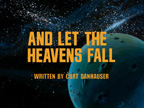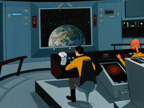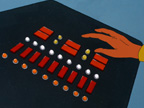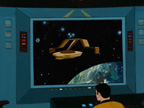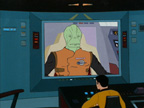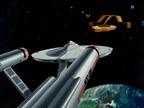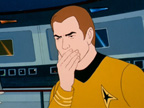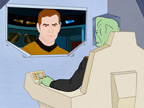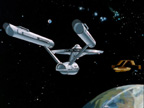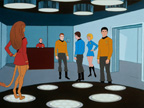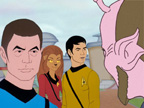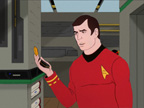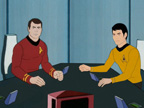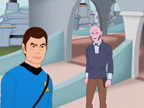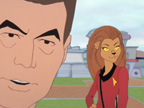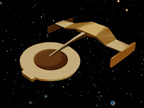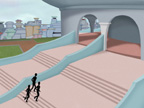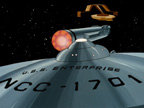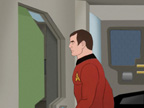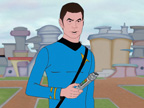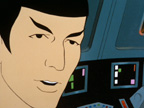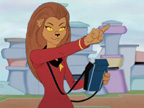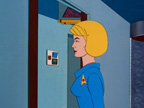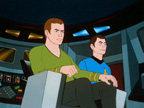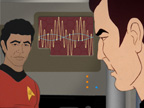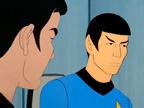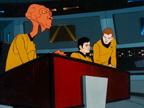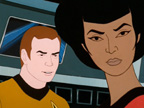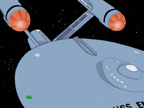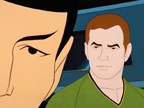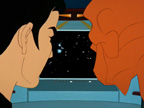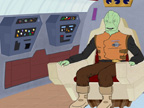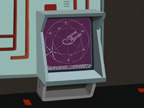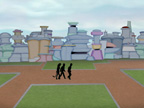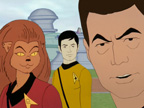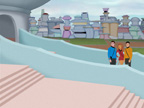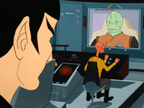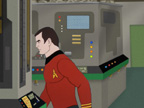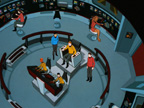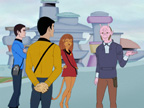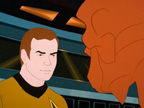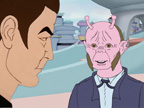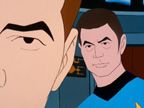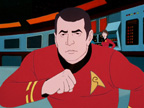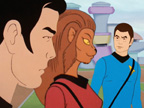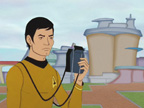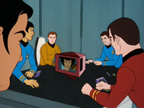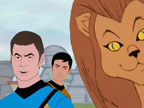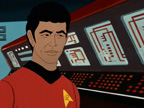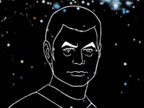|



 |
 |
 


 |
Watch Act I:
Larger Size (640 x 480)
Synopsis
The U.S.S. Enterprise crew comes across a planet with a pre-industrial civilization that seems to be sending radio transmissions into space. While rendering aid to a crippled courier ship in orbit of the planet, they wonder if the two situations are related.
Notes:
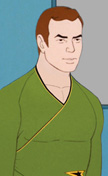 Act IV of this episode marked the first appearance of the captain's leisure wraparound tunic (pictured right) in the animated series.
Act IV of this episode marked the first appearance of the captain's leisure wraparound tunic (pictured right) in the animated series.
- Act I of this episode was released September 8, 2008 - the 35th Anniversary of the animated series's debut on NBC TV. The final complete episode
including Acts I, II, III and IV was released April 25, 2009.
- Kalandra sector mentioned in this episode was a Federation region of space near Betazed, Andor, Tellar and Vulcan. Mentioned in several
STAR TREK: Deep Space Nine episodes: "In the Pale Moonlight", "Once More Unto the Breach", "Afterimage" and "The Reckoning"
- Marcus II, one of the planets that Revik said he was traveling to, was first mentioned in "Requiem For Methuselah" (TOS) as the homeworld of the renowned artist Sten.
-
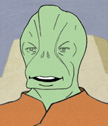 Revik (pictured) is a Gorlan. The original series episode "Mirror, Mirror" mentioned that in the mirror universe the Gorlan uprising
was supressed by destruction of the rebel's homeworld. Also, Gorlan station was a Terran Empire station mentioned in "In a Mirror, Darkly, Part I" [ENT]
Revik (pictured) is a Gorlan. The original series episode "Mirror, Mirror" mentioned that in the mirror universe the Gorlan uprising
was supressed by destruction of the rebel's homeworld. Also, Gorlan station was a Terran Empire station mentioned in "In a Mirror, Darkly, Part I" [ENT]
- This is the only animated episode to feature every character including Kyle and Gabler, although Chapel had no lines.
- Novarra II was located in the Gamma Sagani system which was named for Carl Sagan.
-
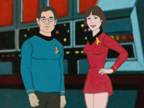 In the scene in Act III where Scotty rushes forward, two crewmembers are seen behind him briefly. They are an animated cameo
appearance of Michael and Denise Okuda who are well known to fans for their visual work as part of the Paramount Pictures Art Department
on all of the STAR TREK television series from the Next generation onward, and also as authors of several books including The STAR TREK Chronology,
The STAR TREK Encyclopedia and the STAR TREK Omnipedia CD-ROMs. They also happen to be good friends of Curt Danhauser the creator of this episode.
In the scene in Act III where Scotty rushes forward, two crewmembers are seen behind him briefly. They are an animated cameo
appearance of Michael and Denise Okuda who are well known to fans for their visual work as part of the Paramount Pictures Art Department
on all of the STAR TREK television series from the Next generation onward, and also as authors of several books including The STAR TREK Chronology,
The STAR TREK Encyclopedia and the STAR TREK Omnipedia CD-ROMs. They also happen to be good friends of Curt Danhauser the creator of this episode.
- This story's denouement is reminiscent of that of the first season STAR TREK: The Next Generation episode "Symbiosis" wherein Captain
Picard does not directly intervene with the appalling situation, but does go so far as to withhold technical
assistance from the villians.
 This episode's story was an intentional homage to series creator Gene Roddenberry who favored stories which touched on the god concept. This episode's story was an intentional homage to series creator Gene Roddenberry who favored stories which touched on the god concept.
- This episode establishes that the U.S.S. Binghamton visited Novarra II in 2220. The Binghamton was named for Binghamton, New York the birthplace
of this episode's creator Curt Danhauser.
- This story was somewhat similar to "Devil's Due" a fourth season STAR TREK: The Next Generation episode which recycled the STAR TREK: Phase II script written by William Douglas Lansford.
- Characters in the episode make direct references to Apollo from "Who Mourns for Adonais?" (TOS) and Kukulkan
from "How Sharper Than A Serpent's Tooth..." (TAS).
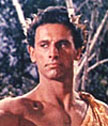
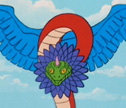
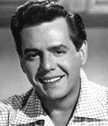 In this episode, we learn that the god that had been revered by the Novarrans before the arrival of Revik was Zanra - The All Father. Zanra was named for Desi Arnaz, the co-founder of Desilu Studios the first studio who
purchased the original STAR TREK series in 1965. Zanra (Arnaz spelled backward) was also used by Mr. Arnaz as the name of a production company in 1956.
Desilu Productions, while mainly being known as the company that made I Love Lucy was also responsible for the invention and popularization of the multi-camera
system used in television production.
In this episode, we learn that the god that had been revered by the Novarrans before the arrival of Revik was Zanra - The All Father. Zanra was named for Desi Arnaz, the co-founder of Desilu Studios the first studio who
purchased the original STAR TREK series in 1965. Zanra (Arnaz spelled backward) was also used by Mr. Arnaz as the name of a production company in 1956.
Desilu Productions, while mainly being known as the company that made I Love Lucy was also responsible for the invention and popularization of the multi-camera
system used in television production. 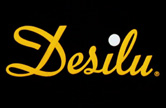 Because it was very expensive, network executives did not want to film episodes, but Arnaz convinced them to allow his production
company to cover all additional costs associated with the filming process, with the stipulation that Desilu owned and controlled all rights to the film. Arnaz's
unprecedented arrangement is widely considered to be one of the shrewdest deals in television history. As a result of his foresight, Desilu reaped the profits from all
reruns of the series.
Because it was very expensive, network executives did not want to film episodes, but Arnaz convinced them to allow his production
company to cover all additional costs associated with the filming process, with the stipulation that Desilu owned and controlled all rights to the film. Arnaz's
unprecedented arrangement is widely considered to be one of the shrewdest deals in television history. As a result of his foresight, Desilu reaped the profits from all
reruns of the series.
- This story also marked the first appearances in the animated series of the universal translator, the radiation vest and the so-called trident scanner.
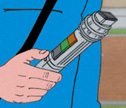

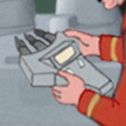
- In this story, McCoy mistakenly ascribes the Latin quote "Fiat Justitia Ruat Caelum" to Cicero. Marcus Tullius Cicero was
the source of a quote which forms the title of the seventh season STAR TREK: Deep Space Nine episode "Inter Arma Enim Silent Leges" (DS9). Other Latin STAR TREK episode
titles are "Sub Rosa" (TNG), "Dramatis Personae" (DS9), "Ex Post Facto" (VGR), "Non Sequitur" (VGR), "Alter Ego" (VGR), "Terra Nova" (ENT) and "Vox Sola" (ENT).
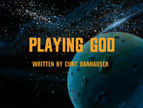
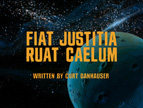 This episode was almost titled "Fiat Justitia Ruat Caelum" the Latin motto quoted by Kirk which means "Do justice and let the heavens fall." The title was changed
to "And Let the Heaven's Fall" to be less obscure. The working title of the episode was "Playing God" even though that was the title of a
STAR TREK: Deep Space Nine episode and because it gave away too much of the plot.
This episode was almost titled "Fiat Justitia Ruat Caelum" the Latin motto quoted by Kirk which means "Do justice and let the heavens fall." The title was changed
to "And Let the Heaven's Fall" to be less obscure. The working title of the episode was "Playing God" even though that was the title of a
STAR TREK: Deep Space Nine episode and because it gave away too much of the plot.
 This animation featured dozens of brand new scenes not seen in the original animation series. A new view of the U.S.S. Enterprise from overhead (shown below center) was seen at the beginning of the final act. In 1973, when creating shots of the Enterprise in space for the animated series, the Filmation team rotoscoped a number of shots from the original live action STAR TREK series. One of the stock shot familiarization sheets that were used by Filmation animators during the run of the show is shown below right. At the bottom of the full sized sheet can be seen "Stock 1008." This animated sequence was planned but never made for the animated series. I decided to create such a shot for my animated episode which I accomplished by using images captured from the original series DVD. Below left are two images showing a side-by-side comparison of the studio model version and my animated version. By the way, the shot below was lent to the makers of the animated Farragut episodes for use in their second episode, "The Needs of the Many." This animation featured dozens of brand new scenes not seen in the original animation series. A new view of the U.S.S. Enterprise from overhead (shown below center) was seen at the beginning of the final act. In 1973, when creating shots of the Enterprise in space for the animated series, the Filmation team rotoscoped a number of shots from the original live action STAR TREK series. One of the stock shot familiarization sheets that were used by Filmation animators during the run of the show is shown below right. At the bottom of the full sized sheet can be seen "Stock 1008." This animated sequence was planned but never made for the animated series. I decided to create such a shot for my animated episode which I accomplished by using images captured from the original series DVD. Below left are two images showing a side-by-side comparison of the studio model version and my animated version. By the way, the shot below was lent to the makers of the animated Farragut episodes for use in their second episode, "The Needs of the Many."
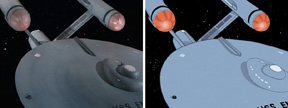
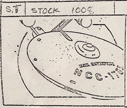
 The Novarran villagers make no mention of the landing party's humanoid appearance, suggesting that the planet may have been
visited by humanoid merchants in the past or perhaps the planet has more than one sentient species with the other one
being more humanlike in appearance. Or perhaps they are naturally not xenophobic.
The Novarran villagers make no mention of the landing party's humanoid appearance, suggesting that the planet may have been
visited by humanoid merchants in the past or perhaps the planet has more than one sentient species with the other one
being more humanlike in appearance. Or perhaps they are naturally not xenophobic.
Images from the Episode:
Read the Official Press
Release
|


   
   
   



|








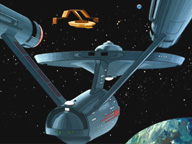















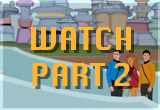
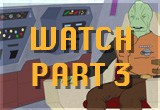
 Act IV of this episode marked the first appearance of the captain's leisure wraparound tunic (pictured right) in the animated series.
Act IV of this episode marked the first appearance of the captain's leisure wraparound tunic (pictured right) in the animated series.


 This episode's story was an intentional homage to series creator Gene Roddenberry who favored stories which touched on the god concept.
This episode's story was an intentional homage to series creator Gene Roddenberry who favored stories which touched on the god concept.


 In this episode, we learn that the god that had been revered by the Novarrans before the arrival of Revik was Zanra - The All Father. Zanra was named for Desi Arnaz, the co-founder of Desilu Studios the first studio who
purchased the original STAR TREK series in 1965. Zanra (Arnaz spelled backward) was also used by Mr. Arnaz as the name of a production company in 1956.
Desilu Productions, while mainly being known as the company that made I Love Lucy was also responsible for the invention and popularization of the multi-camera
system used in television production.
In this episode, we learn that the god that had been revered by the Novarrans before the arrival of Revik was Zanra - The All Father. Zanra was named for Desi Arnaz, the co-founder of Desilu Studios the first studio who
purchased the original STAR TREK series in 1965. Zanra (Arnaz spelled backward) was also used by Mr. Arnaz as the name of a production company in 1956.
Desilu Productions, while mainly being known as the company that made I Love Lucy was also responsible for the invention and popularization of the multi-camera
system used in television production.  Because it was very expensive, network executives did not want to film episodes, but Arnaz convinced them to allow his production
company to cover all additional costs associated with the filming process, with the stipulation that Desilu owned and controlled all rights to the film. Arnaz's
unprecedented arrangement is widely considered to be one of the shrewdest deals in television history. As a result of his foresight, Desilu reaped the profits from all
reruns of the series.
Because it was very expensive, network executives did not want to film episodes, but Arnaz convinced them to allow his production
company to cover all additional costs associated with the filming process, with the stipulation that Desilu owned and controlled all rights to the film. Arnaz's
unprecedented arrangement is widely considered to be one of the shrewdest deals in television history. As a result of his foresight, Desilu reaped the profits from all
reruns of the series.




 This episode was almost titled "Fiat Justitia Ruat Caelum" the Latin motto quoted by Kirk which means "Do justice and let the heavens fall." The title was changed
to "And Let the Heaven's Fall" to be less obscure. The working title of the episode was "Playing God" even though that was the title of a
STAR TREK: Deep Space Nine episode and because it gave away too much of the plot.
This episode was almost titled "Fiat Justitia Ruat Caelum" the Latin motto quoted by Kirk which means "Do justice and let the heavens fall." The title was changed
to "And Let the Heaven's Fall" to be less obscure. The working title of the episode was "Playing God" even though that was the title of a
STAR TREK: Deep Space Nine episode and because it gave away too much of the plot.
 This animation featured dozens of brand new scenes not seen in the original animation series. A new view of the U.S.S. Enterprise from overhead (shown below center) was seen at the beginning of the final act. In 1973, when creating shots of the Enterprise in space for the animated series, the Filmation team rotoscoped a number of shots from the original live action STAR TREK series. One of the stock shot familiarization sheets that were used by Filmation animators during the run of the show is shown below right. At the bottom of the full sized sheet can be seen "Stock 1008." This animated sequence was planned but never made for the animated series. I decided to create such a shot for my animated episode which I accomplished by using images captured from the original series DVD. Below left are two images showing a side-by-side comparison of the studio model version and my animated version. By the way, the shot below was lent to the makers of the animated Farragut episodes for use in their second episode, "The Needs of the Many."
This animation featured dozens of brand new scenes not seen in the original animation series. A new view of the U.S.S. Enterprise from overhead (shown below center) was seen at the beginning of the final act. In 1973, when creating shots of the Enterprise in space for the animated series, the Filmation team rotoscoped a number of shots from the original live action STAR TREK series. One of the stock shot familiarization sheets that were used by Filmation animators during the run of the show is shown below right. At the bottom of the full sized sheet can be seen "Stock 1008." This animated sequence was planned but never made for the animated series. I decided to create such a shot for my animated episode which I accomplished by using images captured from the original series DVD. Below left are two images showing a side-by-side comparison of the studio model version and my animated version. By the way, the shot below was lent to the makers of the animated Farragut episodes for use in their second episode, "The Needs of the Many."


